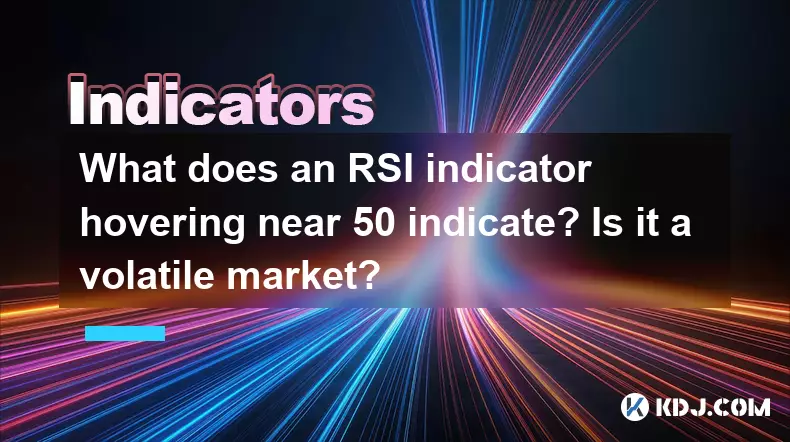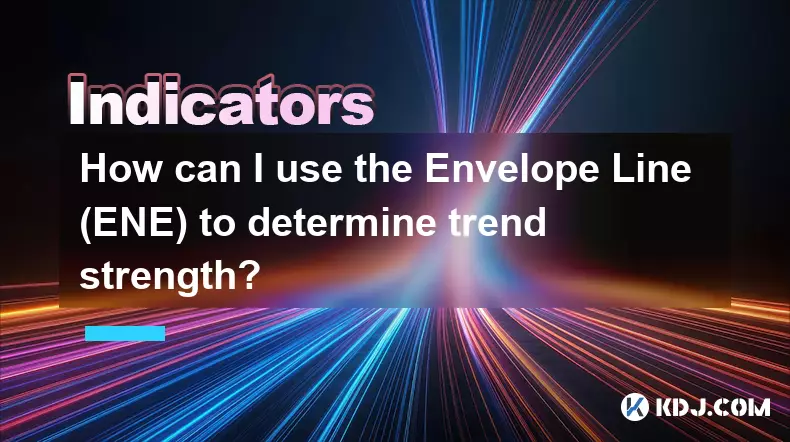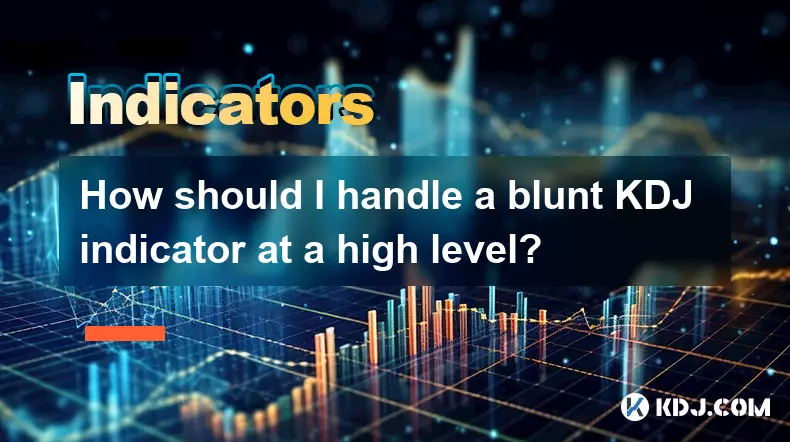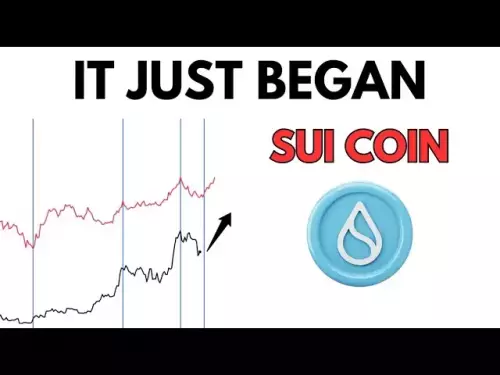-
 bitcoin
bitcoin $117366.968408 USD
0.60% -
 ethereum
ethereum $4611.537173 USD
-0.02% -
 xrp
xrp $3.089373 USD
0.06% -
 tether
tether $1.000286 USD
-0.03% -
 bnb
bnb $986.505381 USD
-0.03% -
 solana
solana $247.629906 USD
0.68% -
 usd-coin
usd-coin $0.999771 USD
-0.03% -
 dogecoin
dogecoin $0.281380 USD
-0.26% -
 cardano
cardano $0.931695 USD
1.71% -
 tron
tron $0.352059 USD
2.40% -
 hyperliquid
hyperliquid $58.226337 USD
-0.94% -
 chainlink
chainlink $24.805082 USD
3.27% -
 avalanche
avalanche $35.625687 USD
10.55% -
 ethena-usde
ethena-usde $1.000922 USD
-0.02% -
 sui
sui $3.883984 USD
2.13%
What does an RSI indicator hovering near 50 indicate? Is it a volatile market?
An RSI near 50 signals neutral momentum, not low volatility—crypto prices can still swing wildly within a tight range despite balanced buying and selling pressure.
Sep 17, 2025 at 11:54 am

Understanding RSI Values Around 50
1. The Relative Strength Index (RSI) is a momentum oscillator widely used in cryptocurrency trading to measure the speed and change of price movements. When the RSI hovers near 50, it suggests that the market is neither overbought nor oversold. This neutral zone often reflects a balance between buying and selling pressure.
2. A reading around 50 typically indicates that recent gains and losses are relatively equal over the observed period, usually 14 days. In the context of the volatile crypto markets, such a value may emerge after a strong trend has lost momentum or during periods of consolidation.
3. Traders interpret an RSI near 50 as a potential transition phase. It does not inherently signal volatility but rather equilibrium. However, because the cryptocurrency space is prone to rapid shifts in sentiment, this equilibrium can be short-lived.
4. During sideways price action or range-bound trading, the RSI frequently oscillates around the midpoint. This behavior is common in altcoins following a major rally or dump when investors are uncertain about the next directional move.
5. While not a direct indicator of volatility, an RSI near 50 can precede increased market activity. If volume begins to rise while RSI remains near 50, it might suggest accumulation or distribution before a breakout.
Neutral Momentum Does Not Equal Low Volatility
1. It's crucial to distinguish between momentum and volatility. An RSI near 50 reflects neutral momentum—neither bullish nor bearish dominance—but says little about price fluctuation magnitude. Cryptocurrencies like Dogecoin or Shiba Inu can exhibit wild intraday swings even when RSI is at 50.
2. High volatility can coexist with neutral RSI if price moves erratically within a tight range. For instance, Bitcoin might swing $2,000 in a day due to news events, yet average gains and losses cancel out, keeping RSI near 50.
3. Market structure plays a role. On lower timeframes like 1-hour or 4-hour charts, RSI frequently revisits 50 during choppy conditions. Scalpers monitor these levels for potential reversals or continuations depending on order book depth.
4. Liquidity vacuums in smaller-cap tokens can cause sharp price spikes that reset momentum quickly, pulling RSI back toward 50 despite high volatility. These conditions are common during low-volume trading sessions or post-fork confusion.
5. Algorithmic trading bots often use RSI thresholds to enter or exit positions. When multiple systems detect RSI near 50, they may initiate counter-trend trades simultaneously, amplifying short-term volatility instead of dampening it.
Practical Use of RSI in Crypto Trading
1. Traders combine RSI with other tools like moving averages or Bollinger Bands to confirm signals. For example, if Bitcoin’s price touches the upper Bollinger Band while RSI is below 50, it may indicate a weak rally lacking momentum.
2. Divergence analysis is particularly effective in crypto markets. A rising price accompanied by a falling RSI near 50 could warn of weakening bullish conviction, especially if seen across large-cap assets like Ethereum or Solana.
3. In trending markets, RSI lingering near 50 may suggest a pause rather than reversal. During bull runs, pullbacks often stabilize around RSI 50 before resuming upward, making it a potential re-entry point for trend followers.
4. Altcoin traders watch for RSI crossovers through 50 as short-term directional cues. A move from 48 to 52 might trigger automated buy orders, creating self-fulfilling momentum in low-liquidity environments.
5. Long-term holders pay less attention to RSI fluctuations near 50, focusing instead on macroeconomic indicators and on-chain metrics. However, swing traders rely heavily on these levels to time entries and manage risk in leveraged positions.
Frequently Asked Questions
Can RSI stay near 50 for extended periods in crypto?Yes, especially during consolidation phases after significant price moves. Stablecoins pegged to fiat rarely show extreme RSI values, but even volatile assets like Avalanche or Polkadot can enter prolonged periods where RSI fluctuates narrowly around 50.
Does RSI near 50 mean a breakout is imminent?Not necessarily. While it can precede a breakout, it may also reflect ongoing indecision without any immediate resolution. Confirmation from volume spikes or candlestick patterns is required to assess breakout probability.
How does leverage trading affect RSI interpretation?In highly leveraged markets like perpetual futures on Binance or Bybit, liquidation cascades can distort RSI readings. A sudden price drop triggered by margin calls may push RSI down temporarily, only to rebound sharply once leverage is flushed out.
Is RSI equally reliable across all cryptocurrencies?No. Major coins with deep liquidity like Bitcoin and Ethereum tend to produce more reliable RSI signals. Low-cap tokens with manipulable order books may generate false signals, where RSI moves erratically regardless of actual market strength.
Disclaimer:info@kdj.com
The information provided is not trading advice. kdj.com does not assume any responsibility for any investments made based on the information provided in this article. Cryptocurrencies are highly volatile and it is highly recommended that you invest with caution after thorough research!
If you believe that the content used on this website infringes your copyright, please contact us immediately (info@kdj.com) and we will delete it promptly.
- Shiba Inu, Binance, and the Stablecoin Surge: What's Driving the Crypto Market?
- 2025-09-20 07:05:12
- Worldcoin's Wild Ride: Price, Market Cap, and What's Next
- 2025-09-20 06:45:12
- UNI Whale's $11M Position: Is Market Attention Justified?
- 2025-09-20 07:05:12
- FTX Repayment Looms: Will Altcoin Prices Get a Market Boost?
- 2025-09-20 06:25:15
- CFTC, Crypto, and Digital Assets: A New York Minute on the Latest Developments
- 2025-09-20 07:05:50
- Solana's $1,000 Dream: Treasuries Surge Fuels Bullish Price Prediction
- 2025-09-20 07:05:50
Related knowledge

How can I use the psychological line (PSY) to determine market sentiment?
Sep 17,2025 at 02:19pm
Understanding the Psychological Line (PSY) in Cryptocurrency TradingThe Psychological Line, commonly referred to as PSY, is a momentum oscillator used...

What does a death cross of the RSI in the strong zone (above 50) mean?
Sep 17,2025 at 10:54pm
Understanding the Death Cross in RSI Context1. The term 'death cross' is traditionally associated with moving averages, where a short-term average cro...

How can I use the Envelope Line (ENE) to determine trend strength?
Sep 19,2025 at 05:00pm
Understanding the Envelope Line (ENE) in Crypto TradingThe Envelope Line, commonly referred to as ENE, is a technical indicator used in cryptocurrency...

How should I handle a blunt KDJ indicator at a high level?
Sep 18,2025 at 09:19pm
Understanding a High-Level Blunt KDJ Indicator1. The KDJ indicator, widely used in cryptocurrency trading, combines the stochastic oscillator principl...

How do I interpret a golden cross above the zero line on the MACD indicator?
Sep 19,2025 at 05:18pm
Understanding the MACD Indicator Structure1. The MACD (Moving Average Convergence Divergence) indicator consists of three main components: the MACD li...

What is the Three Crows candlestick pattern? Is it a scary pattern?
Sep 18,2025 at 03:55am
Understanding the Three Crows Candlestick Pattern1. The Three Crows is a bearish reversal pattern in technical analysis, commonly observed after an up...

How can I use the psychological line (PSY) to determine market sentiment?
Sep 17,2025 at 02:19pm
Understanding the Psychological Line (PSY) in Cryptocurrency TradingThe Psychological Line, commonly referred to as PSY, is a momentum oscillator used...

What does a death cross of the RSI in the strong zone (above 50) mean?
Sep 17,2025 at 10:54pm
Understanding the Death Cross in RSI Context1. The term 'death cross' is traditionally associated with moving averages, where a short-term average cro...

How can I use the Envelope Line (ENE) to determine trend strength?
Sep 19,2025 at 05:00pm
Understanding the Envelope Line (ENE) in Crypto TradingThe Envelope Line, commonly referred to as ENE, is a technical indicator used in cryptocurrency...

How should I handle a blunt KDJ indicator at a high level?
Sep 18,2025 at 09:19pm
Understanding a High-Level Blunt KDJ Indicator1. The KDJ indicator, widely used in cryptocurrency trading, combines the stochastic oscillator principl...

How do I interpret a golden cross above the zero line on the MACD indicator?
Sep 19,2025 at 05:18pm
Understanding the MACD Indicator Structure1. The MACD (Moving Average Convergence Divergence) indicator consists of three main components: the MACD li...

What is the Three Crows candlestick pattern? Is it a scary pattern?
Sep 18,2025 at 03:55am
Understanding the Three Crows Candlestick Pattern1. The Three Crows is a bearish reversal pattern in technical analysis, commonly observed after an up...
See all articles










































































